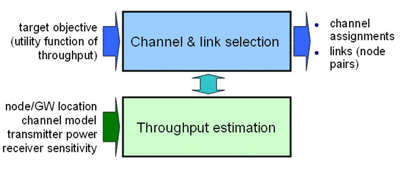by Vangelis Angelakis, Vasilios Siris and Apostolos Traganitis
Wireless mesh networks enable denser coverage and higher data rates than traditional wireless local area networks (LANs), while significantly lowering the deployment and operation costs compared to 3G mobile networks. These cost reductions combined with symmetric bandwidth for uplink/downlink communication will make wireless mesh networks a key architecture for future IP-based radio access networks, enabling innovative pervasive services based on ubiquitous broadband access.
Wireless mesh networks combine three key features: the use of wireless transmission, the multi-hop nature of the end-to-end communication, and the availability of multiple paths. While each of these features raises a host of technical issues, at the same time they provide those advantages that make wireless mesh networks appealing. For instance, wireless transmission offers ubiquitous coverage for both stationary and mobile users; multi-path communication provides dependability in terms of increased network availability and reliability of wireless access to the Internet; and wireless multi-hop communication enables operation with reduced interference and low management costs.

The overall mesh network management consists of the initial configuration, and subsequently adaptation, of procedures and mechanisms to achieve operation of the network according to some performance objectives. In this direction, we are investigating and developing new solutions for key network management functionalities, which include the following:
- power and rate control in metropolitan wireless mesh networks
- channel assignment in metropolitan wireless mesh networks with directional antennas and mesh networks with omni-directional antennas
- topology control in wireless mesh networks with omni-directional antennas.
Key features of our approach include the investigation of the cross-layer interaction of various mechanisms, the investigation of the timescales of management functions, and the combination of analysis and simulation, together with testbed implementation and evaluation. The experimental testbeds include a fourteen-node indoor network with mesh nodes containing four radio interfaces, and a metropolitan mesh network. The latter covers an area of approximately 60 km2 in the city of Heraklion in Crete, Greece and contains fourteen nodes, of which six are core mesh nodes, each containing up to four radio interfaces. The mesh network has two fixed network gateway nodes: one at the Foundation for Research and Technology - Hellas (FORTH) and one at the University of Crete. Another important feature of the metropolitan testbed is an independent overlay network that is used for management and monitoring.
With respect to rate and power control in metropolitan wireless mesh networks with directional links, our results indicate that there are no performance gains when these mechanisms are performed on small timescales, of the order of packet transmission times. Indeed, adaptation of the transmission rate in very small timescales can actually reduce the achievable throughput in the case of low-quality links. For power control, we find that the minimum transmission power to achieve a target minimum performance does not change significantly during the course of a day.
In the area of channel assignment in metropolitan wireless mesh networks, we have developed a practical procedure that accounts for both the interference between links belonging to the same mesh network (intra-network interference), and the interference due to sources external to the network (external interference). The former is captured through a Multi-Point Link Conflict Graph, which is appropriate for networks with directional links that include point-to-multipoint and multipoint-to-multipoint links. On the other hand, external interference is captured through measurement-based channel selection metrics, such as the signal-to-noise ratio or the packet delay.
Similar to the results concerning the timescale of rate and power control, we find that for metropolitan links using IEEE 802.11a technology, there are no significant performance gains to be had by performing channel assignment in short timescales, of the order of hours or even days. These results suggest that changes that affect the mesh networks performance do not occur on small timescales. On the other hand, unexpected events such as anomalies and intrusion attacks should be addressed through appropriate detection and mitigation mechanisms.
In metropolitan wireless mesh networks with directional links, the node connectivity or network topology is known a priori. In contrast, the network topology of wireless mesh networks with omni-directional antennas is not. For such networks, we have developed a framework for joint channel assignment and topology control. The corresponding channel assignment and topology control procedure consists of two modules: the throughput estimation module and the channel and link selection module (see Figure 2).

The innovative feature of the proposed framework and procedure is the support for different target objectives, which are expressed as functions of the achievable throughput between mesh nodes. The support for different target objectives is motivated by different operator-dependent requirements in terms of the aggregate throughput, the fairness of the link throughput and the link redundancy.
This research was conducted within the 7th Framework Programme project EU-MESH (Enhanced, Ubiquitous, and Dependable Broadband Access using MESH Networks), ICT-215320.
Links:
http://www.ics.forth.gr/tnl
http://www.eu-mesh.eu
Please contact:
Vasilios Siris
FORTH-ICS, Greece
Tel: +30 2810 391726
E-mail: vsiris![]() ics.forth.gr
ics.forth.gr










